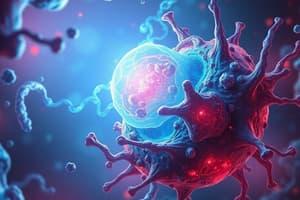Podcast
Questions and Answers
Causes of cell injury can be divided into:
Causes of cell injury can be divided into:
- Hereditary causes
- Acquired causes
- Both A and B (correct)
- None of the above
What is hypoxia?
What is hypoxia?
Shortage of oxygen
Which of the following are physical agents that can cause cell injury?
Which of the following are physical agents that can cause cell injury?
- Trauma
- Burns
- Deep cold
- Radiation
- All of the above (correct)
What do you think injured cells do?
What do you think injured cells do?
Cells encounter physiologic stress or pathologic stimuli and undergo adaptation (homeostasis).
Cells encounter physiologic stress or pathologic stimuli and undergo adaptation (homeostasis).
Reversible injury is characterized by the ability of the cell to return to its normal state.
Reversible injury is characterized by the ability of the cell to return to its normal state.
Which of the following can lead to cell death?
Which of the following can lead to cell death?
Cell death is the ultimate result of cell injury: Necrosis, Apoptosis, Pyroptosis, Autophagy..etc.
Cell death is the ultimate result of cell injury: Necrosis, Apoptosis, Pyroptosis, Autophagy..etc.
What are the two forms of cell death?
What are the two forms of cell death?
Which type of cell death marked by the blue arrow?
Which type of cell death marked by the blue arrow?
What is necrosis?
What is necrosis?
Match the stages of necrosis in the correct order:
Match the stages of necrosis in the correct order:
Apoptosis: cytoplasmic blebs --> apoptotic bodies --> phagocytosis
Apoptosis: cytoplasmic blebs --> apoptotic bodies --> phagocytosis
The main difference between apoptosis & necrosis is that apoptosis occurs in an organized fashion and necrosis occurs without a nuclear signal/order.
The main difference between apoptosis & necrosis is that apoptosis occurs in an organized fashion and necrosis occurs without a nuclear signal/order.
Which of the following is a type of cellular adaptation?
Which of the following is a type of cellular adaptation?
What is Hyperplasia?
What is Hyperplasia?
Physiologic hyperplasia includes:
Physiologic hyperplasia includes:
What is Hypertrophy?
What is Hypertrophy?
Physiologic hypertrophy includes:
Physiologic hypertrophy includes:
This lady has thyroid problem due to less iodine intake, which hypertrophy type you guess?
This lady has thyroid problem due to less iodine intake, which hypertrophy type you guess?
Causes of atrophy may include which of the following?
Causes of atrophy may include which of the following?
Flashcards
Causes of Cell Injury
Causes of Cell Injury
Factors that lead to damage in cells, can be hereditary or acquired.
Hypoxia
Hypoxia
A condition where there is not enough oxygen for cells.
Necrosis
Necrosis
Pathologic cell death that causes inflammation in tissues.
Apoptosis
Apoptosis
Signup and view all the flashcards
Irreversible Cell Injury
Irreversible Cell Injury
Signup and view all the flashcards
Reversible Cell Injury
Reversible Cell Injury
Signup and view all the flashcards
Hyperplasia
Hyperplasia
Signup and view all the flashcards
Hypertrophy
Hypertrophy
Signup and view all the flashcards
Atrophy
Atrophy
Signup and view all the flashcards
Metaplasia
Metaplasia
Signup and view all the flashcards
Necrosis Types
Necrosis Types
Signup and view all the flashcards
Caseation Necrosis
Caseation Necrosis
Signup and view all the flashcards
Liquefactive Necrosis
Liquefactive Necrosis
Signup and view all the flashcards
Coagulative Necrosis
Coagulative Necrosis
Signup and view all the flashcards
Fat Necrosis
Fat Necrosis
Signup and view all the flashcards
Pyroptosis
Pyroptosis
Signup and view all the flashcards
Cellular Adaptation
Cellular Adaptation
Signup and view all the flashcards
Physiologic Hyperplasia
Physiologic Hyperplasia
Signup and view all the flashcards
Pathologic Hyperplasia
Pathologic Hyperplasia
Signup and view all the flashcards
Physiologic Hypertrophy
Physiologic Hypertrophy
Signup and view all the flashcards
Pathologic Hypertrophy
Pathologic Hypertrophy
Signup and view all the flashcards
Atrophy Causes
Atrophy Causes
Signup and view all the flashcards
Brain Atrophy
Brain Atrophy
Signup and view all the flashcards
Neurogenic Atrophy
Neurogenic Atrophy
Signup and view all the flashcards
Dysplasia
Dysplasia
Signup and view all the flashcards
Relationship of Metaplasia and Cancer
Relationship of Metaplasia and Cancer
Signup and view all the flashcards
Cell Death Impact
Cell Death Impact
Signup and view all the flashcards
Difference between Apoptosis and Necrosis
Difference between Apoptosis and Necrosis
Signup and view all the flashcards
Study Notes
Cellular Adaptation
- Cellular adaptation describes how cells respond to various stimuli, maintaining homeostasis or altering their structure and function.
- Adaptation can be reversible, if the stimulus ceases, or irreversible, leading to cell death.
Causes of Cell Injury
- Cell injury can be caused by a variety of factors grouped as hereditary or acquired.
- Hypoxia (oxygen deprivation) is a common cause.
- Physical agents like trauma, burns, radiation, and extreme temperatures.
- Chemicals, including high concentrations of specific substances, alcohol, and smoke.
- Infectious agents, such as bacteria and viruses.
- Immunological reactions, for example, eczema or systemic lupus erythematosus (SLE).
- Genetic mutations.
Morphogenesis of Cell and Intercellular Matrix Injury
- Infiltration: Excessive accumulation of metabolites in cells and the surrounding matrix.
- Decomposition (phanerosis): Breakdown of cellular and extracellular membranes.
- Perverted synthesis: Production of abnormal substances incompatible with normal cellular/tissue function.
- Transformation of initial metabolites to atypical end products.
Cell Injury
- Cells encounter physiologic or pathologic stimuli adapting to preserve viability and function.
- Reversible cell injury is when cells can revert to their normal state after the stimulus ceases, including processes like hyperplasia, hypertrophy, atrophy, and metaplasia.
- Irreversible injury means the cell can't recover, resulting in cell death (necrosis or apoptosis).
- The outcome of cell injury depends on the type, severity, and duration of the injury, and the specific cell type.
Irreversible Cell Injury
- Severe or persistent stimuli result in irreversible cell injury.
- Ultimate cell death can occur through necrosis, apoptosis, pyroptosis, or autophagy.
- Necrosis is a pathological process associated with inflammation.
- Apoptosis is a programmed cell death regulated by specific biochemical processes.
- Necrosis vs. Apoptosis: Necrosis is unorganized/chaotic and inflammatory, whereas apoptosis is ordered/regulated and doesn’t evoke inflammation. Necrosis causes cells and their contents to spill out into the tissue.
Necrosis
- Necrosis is a form of cell death characterized by the breakdown of cellular components.
- It leads to the disruption of cell membranes and the release of cellular contents causing inflammation.
- Necrosis is a pathological process and associated with various types including coagulative, liquefactive, caseous, and fat necrosis.
Apoptosis
- Apoptosis is a programmed cell death process crucial for development and homeostasis.
- It involves cytoplasmic blebbing, formation of apoptotic bodies, resulting in phagocytosis.
- It's a regulated process and does not cause inflammation.
- Apoptosis might indicate DNA damage and apoptosis failure may lead to cancerous phenotypes.
Cell Adaptation Processes
- Hyperplasia is an increase in the number of cells.
- Physiological: Occurs during normal development or in response to specific physiological stimuli (hormonal hyperplasia, compensatory hyperplasia)
- Pathological: Occurs due to aberrant signals (hormonal hyperplasia, viral infections)
- Hypertrophy is an increase in the size of cells.
- Physiological: Skeletal muscle hypertrophy due to exercise
- Pathologic: Cardiac hypertrophy due to hypertension
- Atrophy: Reduction in cell size.
- Physiological: Normal aging
- Pathological: Loss of trophic hormones, diminished blood supply, nerve injury, or disuse
- Metaplasia: Replacing one cell type with another as an adaptive strategy.
- Pathological (often): Replacement of respiratory columnar cells to squamous cells when exposed to irritants
Studying That Suits You
Use AI to generate personalized quizzes and flashcards to suit your learning preferences.




